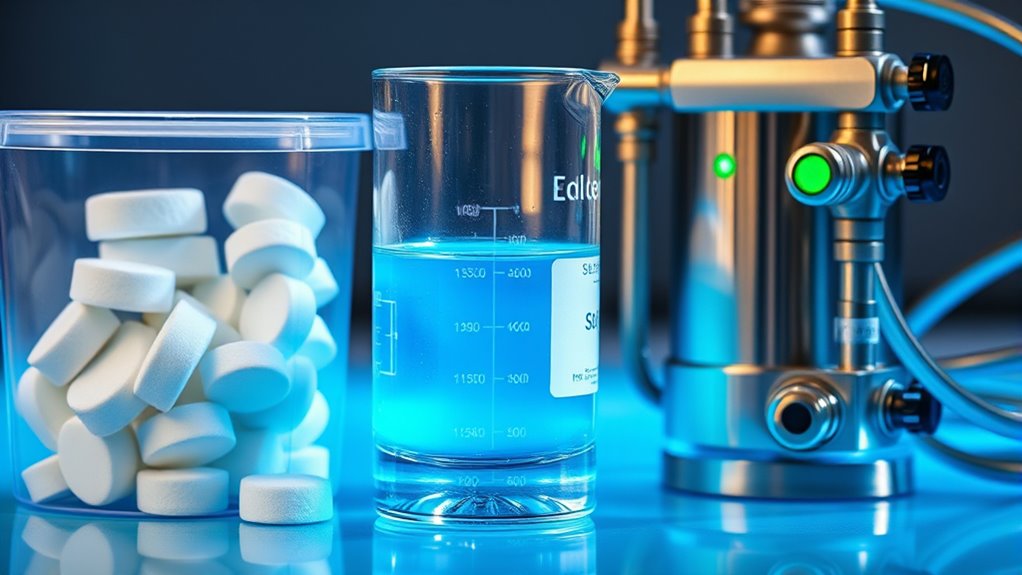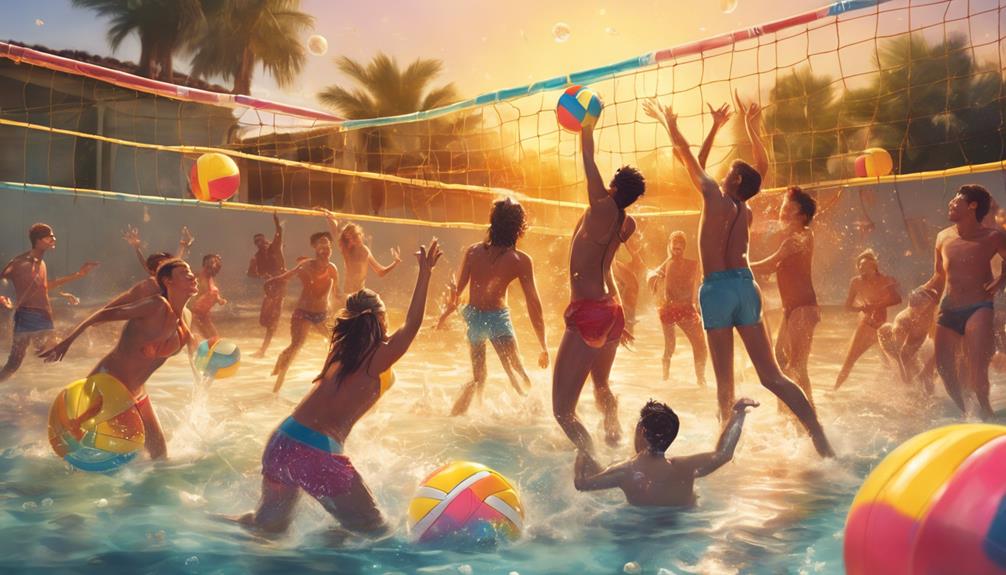Chlorination methods include tablets, liquid solutions, and saltwater systems, each suited for different needs. Tablets are portable and easy to use, making them perfect for small-scale or emergency water treatment. Liquid chlorine offers precise dosing and quick action for larger systems, such as homes or municipal plants. Saltwater systems generate chlorine automatically through electrolysis, providing continuous disinfection with minimal manual effort. To better understand which method best fits your situation, keep exploring these options.
Key Takeaways
- Chlorination methods include tablets, liquid solutions, and saltwater systems, each suited for different scales and needs.
- Tablets are portable, easy to use, and ideal for small-scale or emergency water treatment.
- Liquid chlorine offers precise dosing and is commonly used in larger or municipal water systems.
- Saltwater systems generate chlorine on-site via electrolysis, providing continuous and automated disinfection.
- Proper application and adherence to guidelines are essential for effective disinfection and ensuring water safety.

Have you ever wondered how water treatment plants guarantee safe drinking water? It all comes down to effective disinfection techniques that eliminate harmful pathogens and contaminants. Among the water treatment options available, chlorination stands out as one of the most reliable and widely used methods. Chlorination methods include tablets, liquid solutions, and saltwater systems, each offering unique advantages depending on your needs and circumstances.
Effective water disinfection relies on various chlorination methods to ensure safe drinking water.
Chlorine tablets are a popular choice for their convenience and ease of use. They’re compact, portable, and don’t require extensive equipment, making them ideal for emergency situations, camping, or small-scale water treatment. When you add these tablets to water, they dissolve slowly, releasing chlorine that kills bacteria, viruses, and other pathogens. This method provides a consistent dose of disinfectant, ensuring the water remains safe for drinking over a period. It’s important to follow the instructions carefully to achieve the right contact time and concentration, as improper use can jeopardize water safety.
Liquid chlorine solutions are another common water treatment option. They are typically used in larger-scale or municipal water treatment plants, but can also be effective for home use. These liquids are easier to dose precisely, allowing you to adjust the amount based on the volume of water you’re treating. When you add liquid chlorine, it quickly disperses throughout the water, providing rapid disinfection. This method is versatile and efficient, especially when treating larger quantities of water or when precise control over chlorine levels is required. It also enables easier storage and transportation compared to tablets.
Saltwater systems, often associated with salt chlorination, are increasingly popular for pool disinfecting but are also applicable to water treatment in certain contexts. These systems generate chlorine on-site through an electrolysis process that converts salt into chlorine. If you’re considering this option, you’ll need a saltwater chlorination system and a steady supply of salt. It’s a highly automated, low-maintenance approach that continuously produces chlorine, maintaining a consistent level of disinfection in water. This method reduces the need to handle chemicals directly and can be more economical over time, especially for larger volumes of water. Additionally, advancements in sound healing science have contributed to understanding how sound vibrations can enhance cellular regeneration, which parallels how effective disinfection promotes overall health.
Each of these chlorination methods offers distinct benefits and fits different water treatment scenarios. Whether you choose tablets for portability, liquid for precision, or saltwater systems for automation, understanding these options helps you select the best approach for safe drinking water. Regardless of the method, proper application and adherence to guidelines ensure effective disinfection and protect your health by eliminating harmful microorganisms.
Frequently Asked Questions
Which Chlorination Method Is Most Cost-Effective Long-Term?
You’ll find saltwater systems to be the most cost-effective long-term chlorination method. They offer a favorable cost comparison over tablets and liquid options, mainly due to lower ongoing chemical expenses. Although installation complexity is higher initially, saltwater systems tend to require less maintenance and fewer replacements over time, saving you money and effort in the long run. This makes them a smart choice if you’re focusing on cost efficiency.
How Do Chlorination Methods Impact Water Taste and Odor?
Your water’s taste and odor can drastically change depending on your chlorination method. For example, tablets often cause a strong taste alteration and lingering odor, making your water less pleasant. Liquid chlorination usually results in a milder impact, while saltwater systems tend to offer better odor control with minimal taste changes. You can choose based on your preferences for taste and odor, ensuring cleaner water without sacrificing flavor.
Are There Health Risks Associated With Different Chlorination Systems?
Yes, there are health concerns linked to different chlorination systems, primarily related to chemical exposure. You might inhale or ingest trace amounts of chlorine or its byproducts, which can cause respiratory issues or skin irritation. Saltwater systems generally produce fewer chemical byproducts, reducing health risks. However, it is crucial to maintain proper system operation and regularly test water quality to minimize potential health concerns associated with chlorination.
How Often Should Maintenance or Replacement Be Performed?
Think of your chlorination system as a trusted guardian; it needs regular check-ins to stay effective. You should follow a maintenance schedule, checking filters and disinfectant levels monthly. Replacement frequency varies: tablets last about a month, liquid refills every few weeks, and saltwater systems typically need salt refills annually. Staying consistent guarantees your water stays safe, and your system functions smoothly without surprises.
Can Multiple Chlorination Methods Be Used Simultaneously?
Yes, you can use multiple chlorination methods simultaneously, but you should consider synergy benefits and method compatibility. Combining methods can improve water quality and system efficiency if they work well together. However, make sure they don’t interfere with each other or cause over-chlorination. Always consult manufacturer guidelines or a pool professional to ensure the methods complement each other safely and effectively, maximizing benefits while avoiding potential issues.
Conclusion
No matter which chlorination method you choose—tablets, liquid, or saltwater systems—you gain control over your water’s safety. While tablets offer convenience and liquid provides quick action, saltwater systems blend modern technology with natural elements. Each method has its strengths, just like the different ways you can enjoy clean, safe water—whether it’s a simple sip or a revitalizing swim. Choose what fits your needs, and embrace the peace of mind that comes with crystal-clear water.










